Influence of Preexisting Structures on Salt Structures in the Kuqa Depression, Tarim Basin, Western China Insights from Seismic Data and Numerical Simulations
The Kuqa Depression is an important oil and gas-bearing basin in western China with complex salt structural deformation, showing significant variations in different structural belts and at different locations within the same structural belt. Preexisting basement structures play a crucial role in the process of salt structural deformation. Using the latest two-dimensional and three-dimensional seismic data, combined with discrete element and finite element numerical simulation methods, this study investigates the types and distribution of preexisting structures and their control on salt structures. Seismic data analysis indicates that the preexisting structures developed in the Kuqa Depression mainly include basement faults, paleo-uplifts, subsalt slopes, and early passive salt diapirs. Basement faults are mainly distributed in the Kelasu and Qiulitag structural belts, controlling the development location and deformation style of the Miocene compressional salt structures. Differences in the deformation style and reactivation degree of basement faults have led to the diversity of salt structures in different structural belts. Paleo-uplifts mainly include the Wensu Uplift, western Qiulitag Uplift, Xinhe Uplift, and Yaha-Luntai Uplift; paleo-uplifts limited the original sedimentary extent and later deformation space of the salt layer, resulting in strong salt thrusting in different structural layers of the Awate Sag in the western Kuqa Depression. The non-uniform spatial distribution of paleo-uplifts also promoted the development of large-scale strike-slip transfer zones in the western part of the depression. Subsalt slopes are mainly located on the northern margin of the western Qiulitag low uplift, hindering the southward flow of salt and forming large-scale salt domes at the edge of the slopes, with the size of these domes being closely related to the dip of the subsalt slopes. Early passive salt diapirs are mainly developed in the Quele and Bozidun areas of the western Kuqa Depression, and they were preferentially active during the post-Miocene compressional period, forming a piercement salt nappe. Numerical simulation results show that preexisting structures have a strong control on the stress-strain distribution during salt structural deformation, often causing stress concentration of maximum principal stress and shear stress, thereby inducing the preferential formation of salt structures. Seismic data and numerical simulation results indicate that the spatial heterogeneity of basement structures is an important factor in the north-south structural zonation and east-west structural segmentation of the Kuqa Depression, as well as an important inducing factor for the formation of local piercement salt structures. (Yang et al.,2024)。
[Yang, K., Qi, J., Xu, L., Yu, Y., Sun, T., Shen, F., ... & Zhao, H. 2024. Influence of preexisting structures on salt structures in the Kuqa Depression, Tarim Basin, Western China: Insights from seismic data and numerical simulations.*Basin Research, 36(1), e12850.](https://doi.org/10.1111/bre.12850) #### TitleInfluence of preexisting structures on salt structures in the Kuqa Depression, Tarim Basin, Western China: Insights from seismic data and numerical simulations
Keji Yang1, Jiafu Qi2,Liangwei Xu3*, Yanqiu Yu1, Tong Sun4, Fangle Shen5, Li Peng6, Ji Lv6, Hanting Zhao 6
- Hebei Key Laboratory of Strategic Critical Mineral Resources, College of Earth and Science, Hebei GEO University, Shijiazhuang, China
- State Key Laboratory of Petroleum Resources and Prospecting, College of Earth and Science, China University of Petroleum (Beijing), Changping, Beijing, China
- School of Resources and Environment, Henan Polytechnic University, Jiaozuo, China
- Research Institute of Exploration and Development, Dagang Oilfield, CNPC, Tianjin, China
- Huaxin College of Hebei GEO University, Shijiazhuang, China
- Bureau of Geophysics Prospecting Inc., CNPC, Research Center of Geology, Zhuozhou, China
Abstract
The preexisting structures that developed in the basement and subsalt strata play a key role in the salt structural deformation in the Kuqa Depression, Tarim Basin. The characteristics of preexisting structures and their controls on the salt structure are investigated via the latest three-dimensional seismic data and numerical modelling. The results show that the preexisting structures that developed in the Kuqa Depression mainly consist of basement faults, palaeouplifts, subsalt slopes and early passive salt diapirs. Basement faults are mainly distributed in the Kelasu and Qiulitag structural belts and control the position of development and deformation style of the Miocene compressive salt structure. The differences in styles and reactivation degrees of basement faults lead to great diversity in the salt structure. The palaeouplifts mainly include the Wensu, western Qiulitag, Xinhe and Yaha-Luntai palaeouplifts. The original sedimentary range and later deformation space of the salt layer are limited by the palaeouplift, resulting in strong salt thrusting in the Awate sag in the western part of the Kuqa Depression. The heterogeneous spatial distribution of the palaeouplift promoted the development of regional strike-slip transform belts. Subsalt slopes are located mainly on the northern edge of the western Qiulitag low uplift and block the southward flow of the salt, causing the salt to form salt domes; the size of these domes is closely related to the subsalt slope. Early passive salt diapirs mainly developed in the Quele and Bozidun areas of the western Kuqa Depression, and they were preferentially active during the compression period, inducing the formation of a piercement salt nappe. Numerical modelling revealed that the preexisting structure strongly controlled the stress–strain distribution during the deformation of the salt structure. The spatial distribution heterogeneity of the basement structure is an important factor in the structural zonation along the north–south strike and segmentation along the west–east strike in the Kuqa Depression, as well as an important inducer of the piercement salt structure.
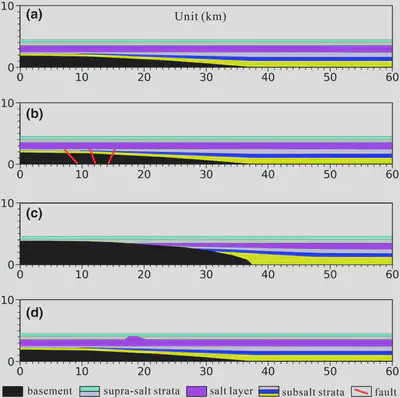
FIGURE 13 Model settings of the discrete-element numerical simulation experiment. (a) Model A—Basic model; (b) Model B—Preexisting fault model; (c) Model C—Preexisting palaeouplift model; and (d) Model D – Preexisting salt diapir model. All the models are 60 km long and 4.5 km high and are extruded from the right edge with a 15 km compressive distance. The elements are bonded to the base and sidewalls, and the gravitational field is calculated.
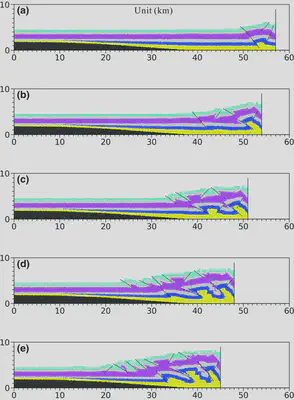
FIGURE 14 Experimental process of Model A. From (a) to (e), the compressive distance is 3, 6, 9, 12 and 15 km respectively. On the whole, the structural deformation of each structural layer gradually propagates from right to left, and the propagation distance of super-salt deformation is larger than that of the subsalt deformation.
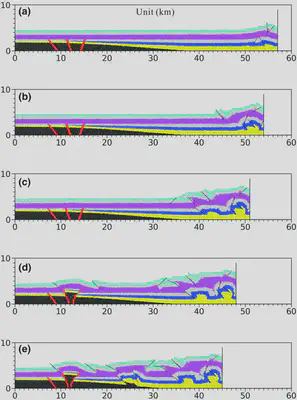
FIGURE 15 Experimental process of Model B. From (a) to (e), the compressive distance is 3, 6, 9, 12 and 15 km respectively. The preexisting faults away from the extrusion edge begin to revive when the extrusion reaches 12 km and finally, form a salt diapir at the top of the basement faults.
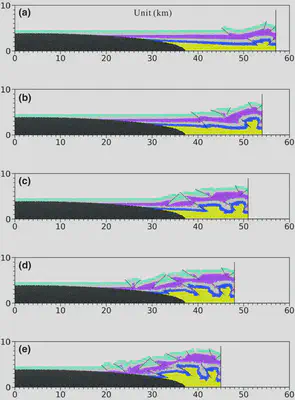
FIGURE 16 Experimental process of Model C. From (a) to (e), the compressive distance is 3, 6, 9, 12 and 15 km respectively. Due to the barrier of the preexisting palaeouplift, the subsalt faults are strongly thrust, and a piercement salt structure is formed on the right edge of the palaeouplift.
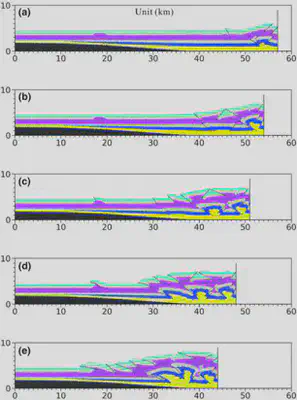
FIGURE 17 Experimental process of Model D. From (a) to (e), the compressive distance is 3, 6, 9, 12 and 15 km respectively. When the extrusion reaches 9 km, the preexisting salt diapir starts to revive and finally evolves into a penetrating salt wall.
Translator: Bao Xianjun